KeyMod vs. M-LOK: AR-15 Handguards Compared
Posted by Gun Builders Depot on Apr 7th 2021
With so many handguards available on the AR parts market, picking the right one can get a little confusing. Is M-LOK better than KeyMod? Does a Picatinny rail still have its place on a modern AR-15? What's the difference between a drop-in handguard and a free-float unit? Let's clear it all up.
Handguard FAQs
Q: What is a drop-in or two-piece handguard?
A: This is the original handguard design found on commercial AR-15s, adopted directly from service-issued M4s and M16s. As the name implies, a two-piece handguard comprises two halves, which meet together at the barrel nut and front sight bus / gas block, clamping together around the barrel and gas tube. These types of handguards typically have a quad Picatinny rail for attachments, or they'll be smooth, provided only as a place to grip with your non-firing hand, like the one below.

This handguard is considered the most "rugged." It would take an exceptional amount of force - likely enough to bend the barrel itself - to dislodge this handguard. The drawback is that such a handguard, when affixed directly to the gas block and barrel, can reduce accuracy. That's where free-float handguards come in.
Q: What is a free-float handguard?
A: A free-float handguard quite literally "floats" over the barrel and gas block. It only attaches at one point on the rifle or pistol, and that's via the barrel nut, which is secured to the front of the upper receiver:

Because the handguard is only attached via the barrel nut, it does not contact the barrel itself or the gas block. These handguards are typically much lighter and more aesthetic. While they may be less "robust", they're still tough enough for combat conditions (we'll review military testing below) and they improve accuracy, especially at greater distances.
Q: How do I determine the best handguard length?
A: That depends on the type of handguard you want to utilize. If you prefer the military look of a drop-in/two-piece guard, you'll need to buy one that matches the length of your AR's gas system, since it connects to the gas block. If you choose a free-float handguard and your AR's equipped with a low-profile gas block that fits underneath the guard, you can install virtually any length you want. You'll probably want a guard long enough to at least cover the gas tube and gas block to protect them from damage. You can get a guard that goes all the way to the muzzle, if you prefer.
Q: Are AR handguards universal?
A: Mostly, yes. The AR is split into two basic platforms: The AR-15, and the AR-10 or LR-308, which is the larger .30-caliber variant. The LR-308/AR-10 uses its a physically wider handguard to accommodate the larger barrels, barrel nuts, and gas blocks, while all AR-15 handguards are "universal" and can be installed on any type of AR-15, regardless of the caliber being chambered (300 Blackout, 5.56, .223, 6.5 Grendel, 9mm, and so on).
Q: Which attachment rail system is the best?
A: We're going to break that down in detail in this guide. The three types are M-LOK, Keymod, and Picatinny. M-LOK and Keymod are "female" attachment systems, in that the rail is the female side and the accessory to be attached uses small bolts and risers to affix to the handguard's various open slots. Picatinny is a "male" attachment system, in that the accessory to be attached uses a female attachment to clamp onto the exposed rails on the Picatinny guard. We're comparing M-LOK and Keymod with this guide, since Picatinny is well established and quite different from the former two.
M-LOK vs. Keymod Rail Systems

This comparison uses data and testing collected from the Naval Surface Warfare Center. NAVSEA compared the most popular brands of M-LOK and Keymod rail systems (Aero Precision, Midwest Industries, and Seekins) by engaging in various torture tests. Their goal was to determine which of the two rail systems was superior. Read below for an in-depth comparison.
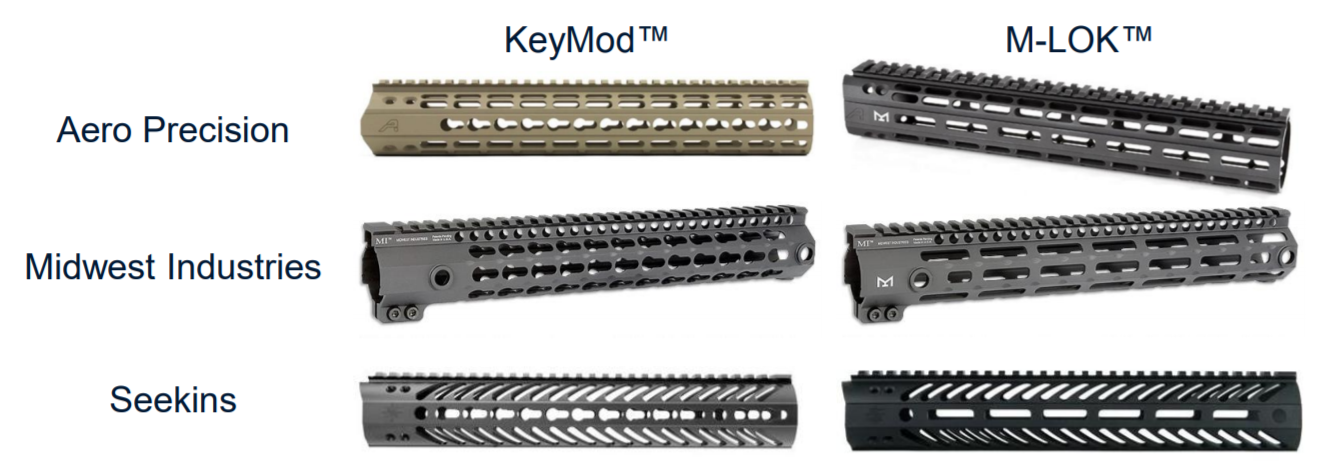
To make the data easy to read, NAVSEA labelled each rail systems alphanumerically:
- A1, A2, A3: Aero Precision (KeyMod)
- A4, A5, A6: Aero Precision (M-LOK)
- B1, B2, B3: Midwest Industries (KeyMod)
- B4, B5, B6: Midwest Industries (M-LOK)
- C1, C2, C3: Seekins (KeyMod)
- C4, C5, C6: Seekins (M-LOK)
Let's dive into the various tests conducted!
Uninstall / Reinstall POA Shift
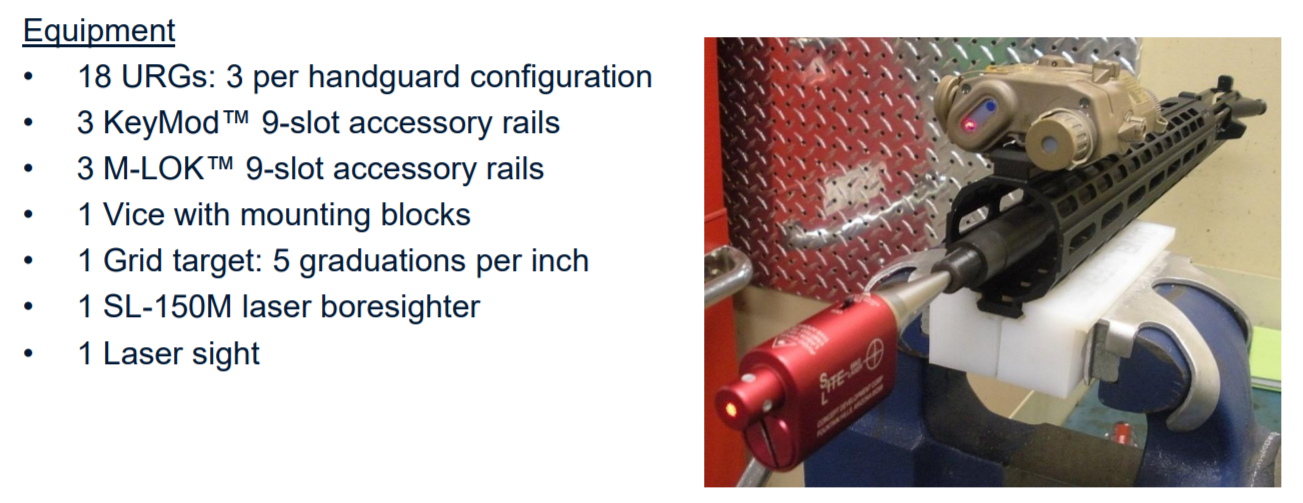
The purpose of this test was to see how much point of aim of an attached laser optic would shift when the handguards were uninstalled and reinstalled. The test optic was a PEQ-15 laser, and point of aim (POA) was measured before and after each handguard was uninstalled and then reinstalled.
Test Results for KeyMod:
- A1, A2, A3 (Aero) Average Shift (MOA): 4.4
- B1, B2, B3 (Midwest) Average Shift (MOA): 7.2
- C1, C2, C3 (Seekins) Average Shift (MOA): 3.2
Test Results for M-LOK:
- A4, A5, A6 (Aero) Average Shift (MOA): 1.7
- B4, B5, B6 (Midwest) Average Shift (MOA): 1.3
- C4, C5, C6 (Seekins) Average Shift (MOA): 0.8
By averaging out the results from each brand of handguard, we can find that POA shifted about 4.9 MOA for KeyMod, and just over 1.2 MOA for M-LOK. The data's also displayed graphically by NAVSEA:
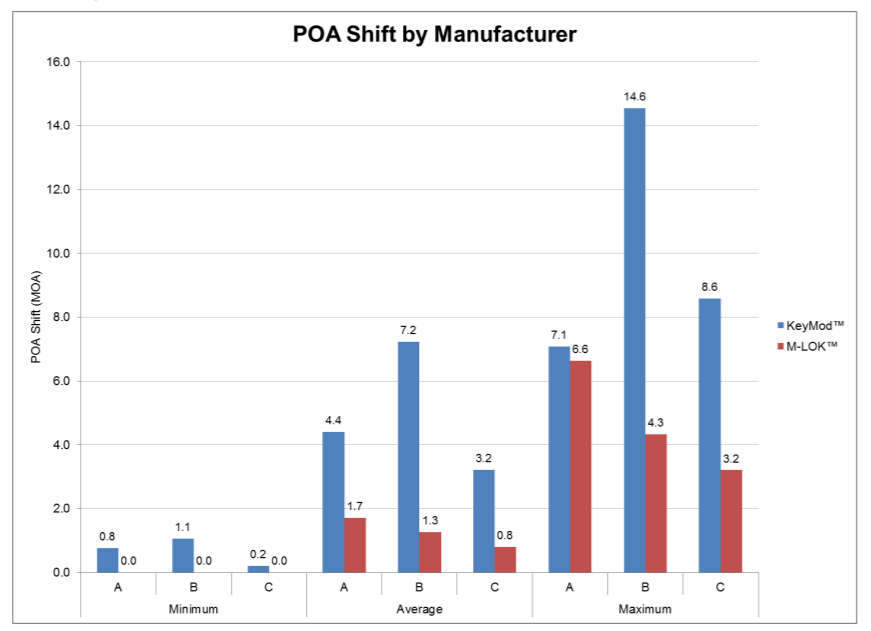
Winner: M-LOK.
Simulated Live Fire Torture Test
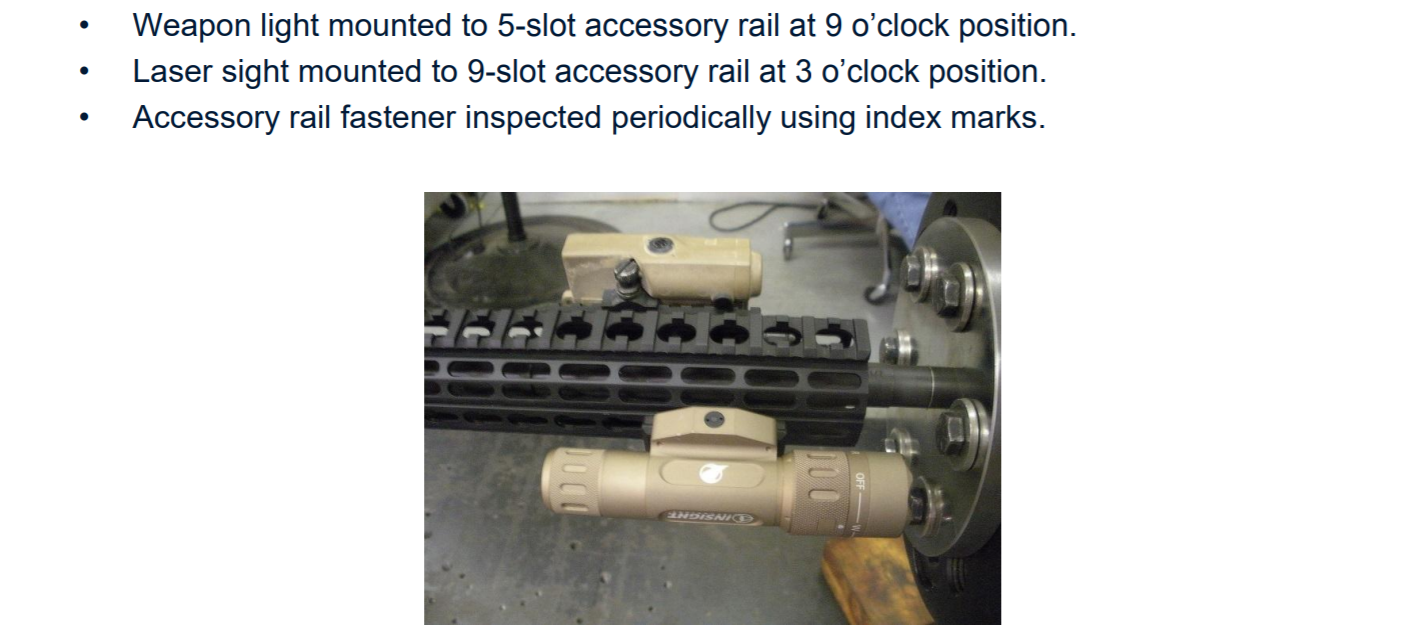
The purpose of this test was to determine which attachment system could hold up to full-auto live fire without attached accessories becoming loose, shifting, or the entire handguard coming loose on the AR. The simulation replicated about 1,000 rounds per minute of full-auto fire in 30-round bursts. Two seconds were allowed between each burst, with a total of 20 bursts conducted, simulating a total of over 10,000 rounds fired downrange. The attached accessories included a weapon light, laser light, and accessory rail fasteners to secure to each handguard.
Both rail systems withstood the entirety of the live-fire torture test without the attachments coming loose or the handguards themselves failing in any manner. This test illustrates that, when accessories are properly torqued to their rail systems, both M-LOK and KeyMod perform just as well each the other.
Winner: Tie.
Rough Handling Torture Test
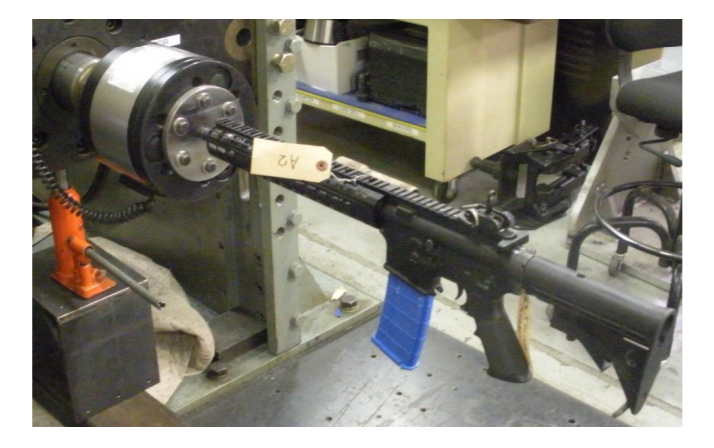
Using the live-fire simulator, the torture test was modified to simulate bumps and bangs on the handguards and their rifles. The tests simulated hard impacts starting at 200 lb. ft., moving up up to 400 lb. ft. The same light and laser accessories were used in their same positions on each rail system for this test.
The results were again the same: Neither attachment system suffered loose or detached accessories, and neither handguard became loose on either rifle.
Winner: Tie.
Drop Torture Test
This is perhaps the most relevant test conducted. After all, we're all most likely to drop our AR or bang it on the ground once or twice. For this torture test, each AR was dropped six times at different angles:

Let's take a look at the damage, shall we?
Aero Precision (KeyMod)
Aero's KeyMod rail suffered no damage on drops 1, 3, and 6. On drop 4, the rear mounting lug that secured the accessory to the handguard failed and was pulled out of the rail system. The handguard suffered a crack in the aluminum slot, which allowed this separation to occur:
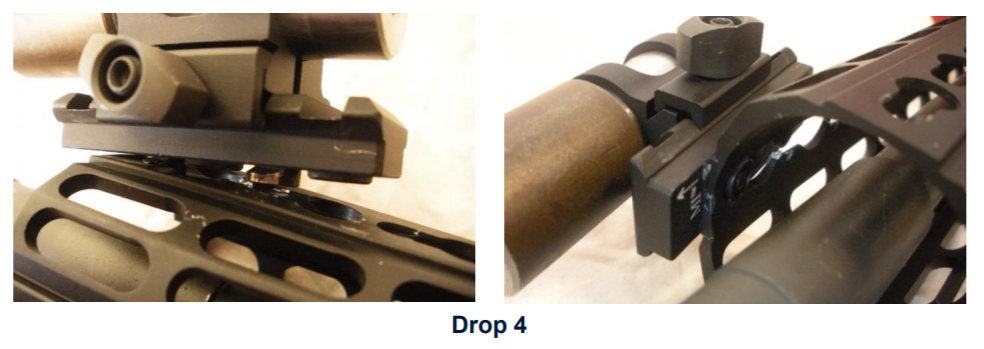
Drop 5 was the final nail in the coffin for this accessory attachment. The rail system failed completely, with both mounting lugs on the accessory failing. This allowed the accessory to separate from the rail's keyholes:

Midwest Industries (KeyMod)
The first drop of the Midwest Industries KeyMod rail resulted in the rail suffering a fracture. The rail suffered no damage on drop 2. Drop 3 resulted in the handguard sliding forward, off the barrel nut, but about half an inch. Drop 4 resulted in the handguard rotating clockwise on the barrel nut, so it was canted at about 30 degrees. A hairline fracture also developed between one of the KeyMod slots:
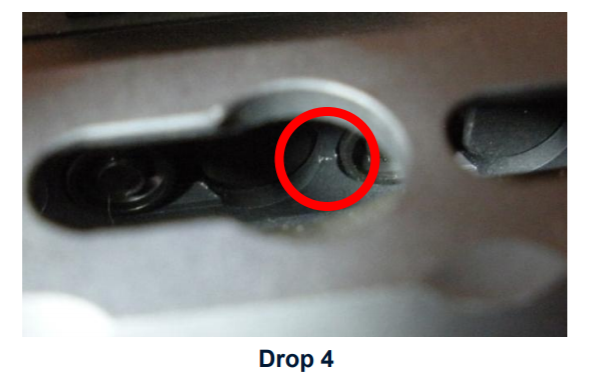
Drop 5 caused the handguard to slide further off the barrel nut, and on drop 6, the handguard separated completely from the barrel nut, so it was no longer attached to the rifle:
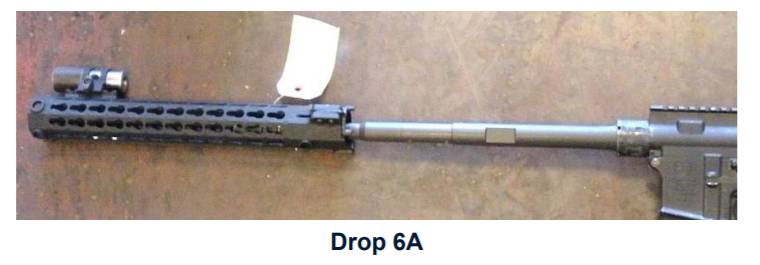
Seekins (KeyMod)
Drop 1 of the Seekins KeyMod rail resulted in no damage. On drop 2, the handguard suffered a small scratch. On drop 3, a slight gap developed between the handguard and receiver, with the guard sliding ever so slightly off the barrel nut. On drop 4, there was further scraping, but no damage. On drop 5, a small fracture developed on one of the rails. Drop 6 resulted in major damage to the handguard, also the accessory remained attached to the rail, with neither lug being separated from the slot:
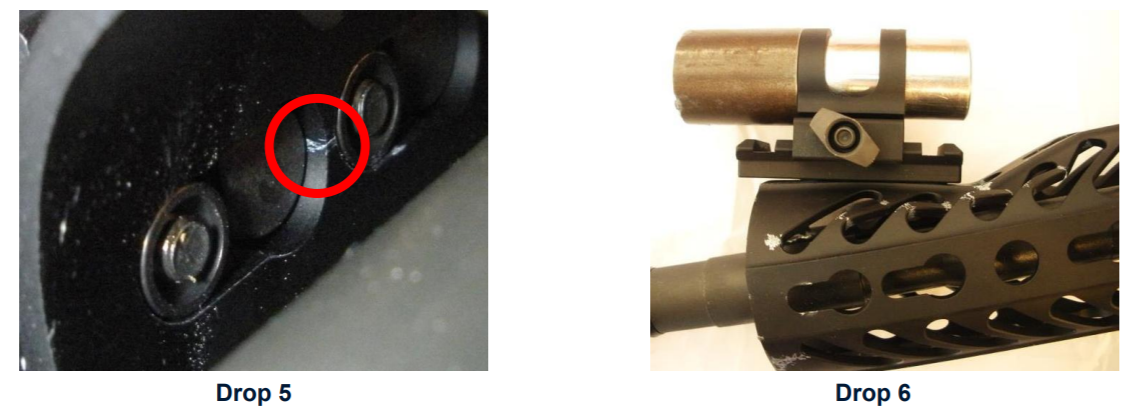
Overall, we've seen the KeyMod rail system is prone to suffering small fractures where accessories are torqued. When the rail suffers no fractures, the accessories tend to remain fixed in place. Let's see how M-LOK fairs with the same drop tests.
Aero Precision (M-LOK)
Aero Precision M-LOK handguard suffered no damage on the first drop. Drop 2 caused a slight deformation to appear where the accessory was attached, but the accessory did not loosen or separate. Drop 3 caused the accessory to slide foward slightly within its mount, but the accessory mount securing it to the M-LOK slots did not loosen. Drop 4 caused a fracture in the handguard, but not where the accessory was mounted. Drop 5 caused no additional damage, while drop 6 caused the accessory to finally loosen and slide rearward in the M-LOK slots, but it did not separate entirely.
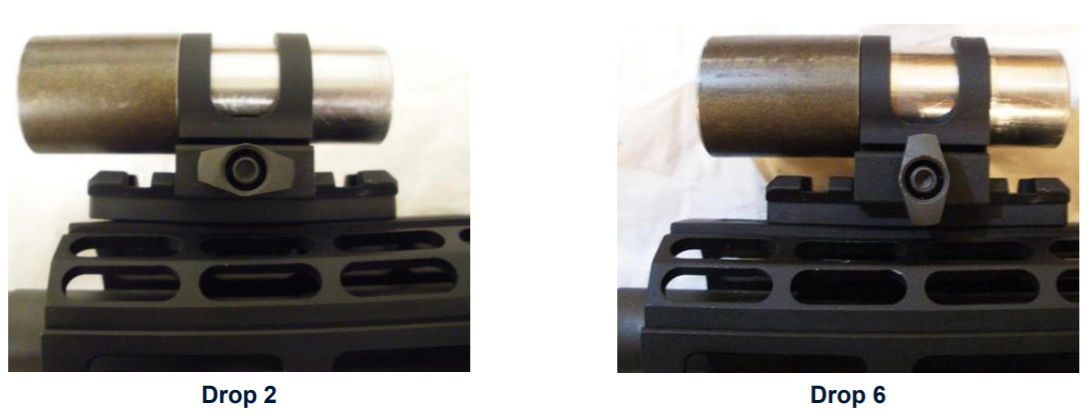
Midwest Industries (M-LOK)
The Midwest M-LOK rail suffered minor damage on drop 1, but the accessory did not loosen. Drop 2 caused no further damage. Drop 3 caused the handguard to slide forward on the barrel nut and rotate slightly. Drop 4 increased this displacement on the barrel nut. Drop 5 caused the handguard to rotate on the nut 45 degrees. Drop 6 caused the handguard to slide back into position, but it damage the torque plate meant to keep the handguard oriented at the 12 o' clock position. The mounted accessory did not loosen at all, and remained torqued to the rail:
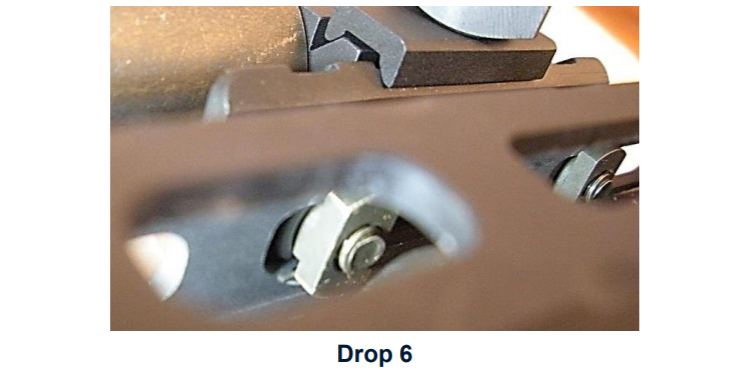
Seekins (M-LOK)
The Seekins M-LOK handguard's mounted accessory rotated slightly within its mount on drop 1. Drop 2 caused no damage. Drop 3 caused the accessory to slide rearward in the M-LOK slots just slightly. Drop 4 caused additional rearward travel of the mount within the slots. Drop 5 caused no damage. Drop 6 caused the accessory rail to slide rearward about 50% of the distance of the slot, but the accessory itself did not separate:
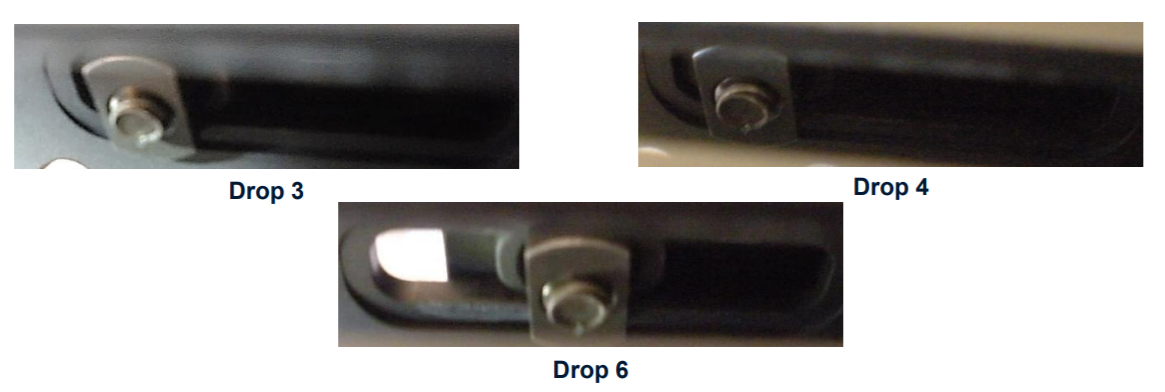
Rail Attachment Slots After Drop Tests
Overall, M-LOK noticeably outperformed KeyMod in the drop tests. After removing the accessories from the rail systems, we can see that the KeyMod slots were damaged, often with cracks. The M-LOK slots suffered no damage beyond superficial scrapes and scratches:
KeyMod Rails after drop tests:

M-LOK Rails after drop tests:
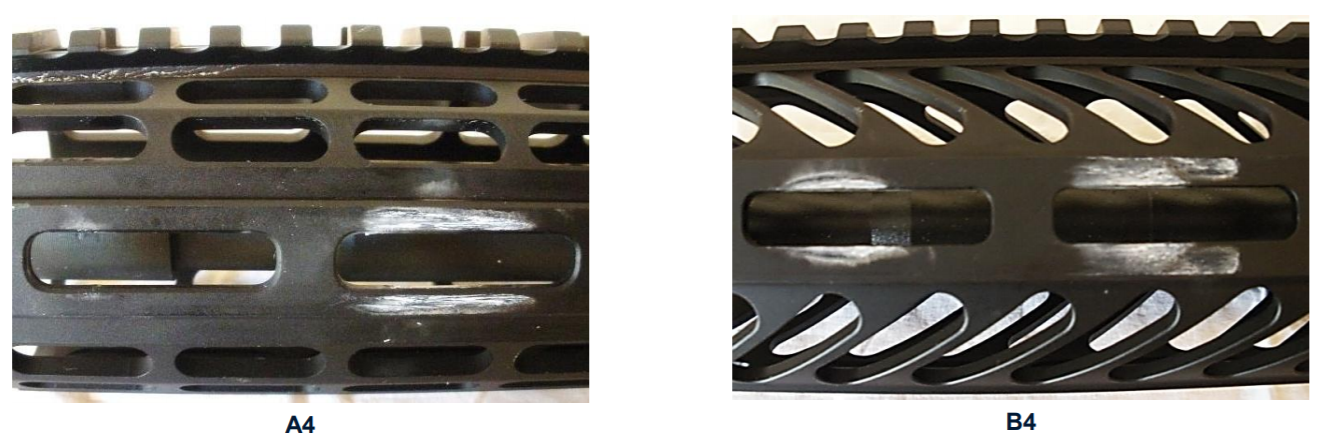
Final Test: Failure Loads
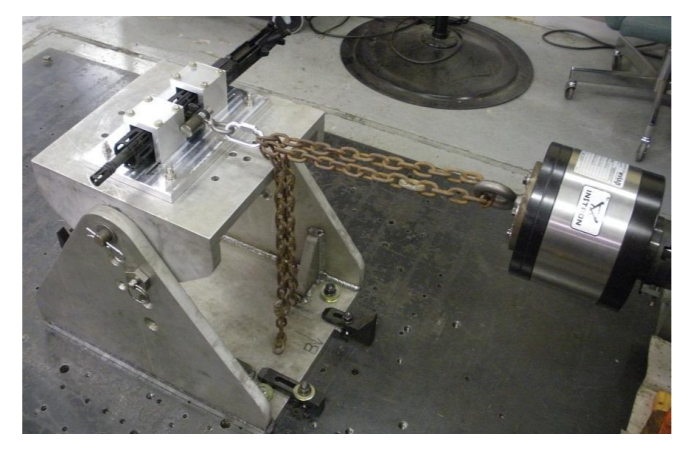
The final test compared which rail system could endure the most load before the accessory and its mount would quite literally rip away from the rail slots. To perform this test, a chain and hook were fixed to the mounted accessory, and the handguard and rifle were clamped into a metal vise. the chain and hook were pulled and the amount of tension measured, until the hook eventually ripped the accessory off the rail, constituting total failure.
Unfortunately for KeyMod, the results are quite apparent. M-LOK far outperformed KeyMod in its ability to maintain a secure mount, before failure. The graph below compares the pound-feet of force required to cause failure on both rail systems, across all three brands of handguards:
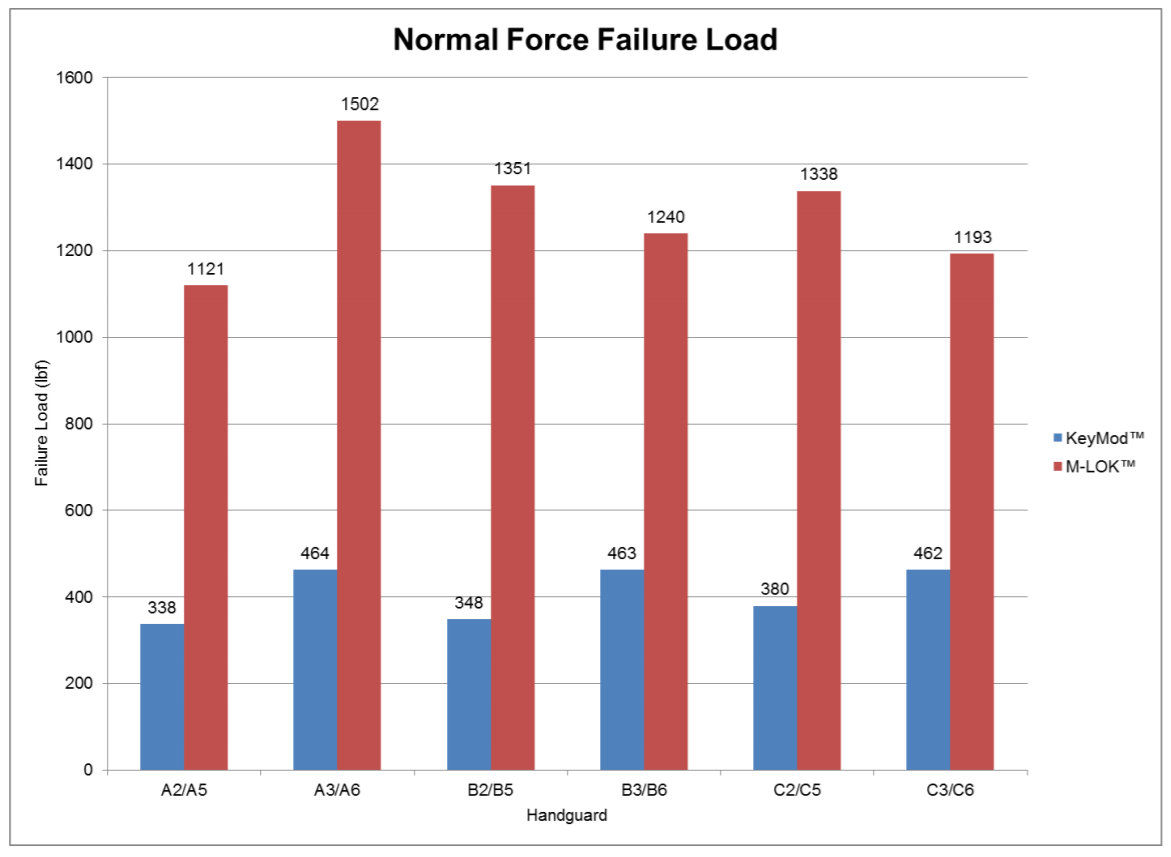
Overall, the M-LOK rail system required about 215% more force to achieve total failure compared to KeyMod.
Overall Winner: M-LOK.
Summary
Overall, M-LOK appears to be the better investment when it comes to picking a good free-float handguard with a female attachment system. Drop-in and two-piece handguards still have their place in the AR community, especially for builders who want to replicate an M16- or M4-type rifle configuration.
DISCLAIMER: If you are new to the world of DIY gun building, you likely have a lot of questions and rightfully so. It’s an area that has a lot of questions that, without the correct answers, could have some serious implications. At GunBuilders.com, we are by no means providing this content on our website to serve as legal advice or legal counsel. We encourage each and every builder to perform their own research around their respective State laws as well as educating themselves on the Federal laws. When performing your own research, please be sure that you are getting your information from a reliable source.

